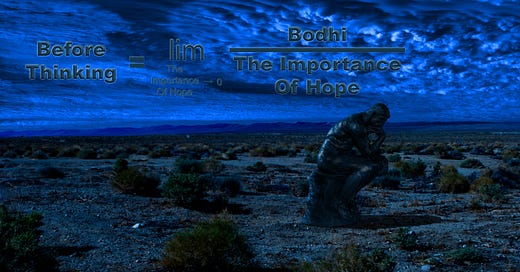“The Prison of Hope”
An Art Review by Alberto Indiana
Kazmier Maslanka’s The Prison of Hope is a mathematical visual poem drenched in sorrowful insight. Set in a barren, cobalt blue desert beneath a sky turned upside-down—a photo taken above the clouds from the window of an airplane—the composition creates an unsettling reversal. The heavens, no longer a realm of transcendence, now appear weighty and unnatural, inverted like a mind caught in its own reflection. The effect is claustrophobic and existential. The atmosphere does not offer hope; it denies it.
At the conceptual center of this austere plane is Auguste Rodin’s The Thinker, cast in bronze and thought. But here, he is neither triumphant nor philosophical. He is stranded, on the earth, cloaked in shadow. In Maslanka’s world, the thinker is not a seeker of truth—he is a prisoner of cognition, a tragic figure ensnared in the very process he believes will save him.
And yet, the image’s most profound gesture is not visual but mathematical. Maslanka overlays the scene with a conceptual equation:
This is no idle formula. It is a meditative weapon aimed at one of our most deeply rooted psychological structures: hope.
The equation reads as follows: Before Thinking is defined as the limit of the expression Bodhi divided by the Importance of Hope, as the Importance of Hope approaches zero. In other words, the smaller the value we place on hope, the more the expression tends toward infinity. This means: as the importance of hope diminishes, the condition of “Before Thinking” becomes boundless.
Here, Bodhi—a Sanskrit term for awakening or enlightenment—is not something gained by hoping. Rather, The importance of Bodhi is what becomes unlimited when the mental habit of placing value on hope disappears. Hope, in Maslanka’s vision, is the very denominator of awakening—the mental construct that keeps realization finite, conceptual, and deferred. As long as one assigns importance to hope, enlightenment remains diluted and distant. But as that importance shrinks—approaches zero—the liberating clarity of “Before Thinking” emerges in full measure.
This is a profound inversion of popular spiritual narrative. In conventional Western frameworks, hope is a virtue. But in Zen and advanced Buddhist philosophy, hope is another name for craving—a future-oriented attachment that displaces the immediacy of truth. Zen master HyonGak Sunim once said, “You don’t need hope if you have Buddha’s mind.” Sam Harris echoes this view when he describes hope as a subtle form of suffering—a refusal to be fully present with what is. Maslanka encodes this sentiment into the logic of limit notation.
Visually, this message is reinforced with ruthless clarity. The desert—lifeless, silent—speaks of a spiritual terrain scorched by longing. The sky, flipped on its head, becomes a metaphor for mental inversion, the way thought and desire turn reality upside down. And Rodin’s Thinker, once a monument to introspection, is reduced to a kind of spiritual fossil—trapped, inert, endlessly circling the axis of his own mind.
The tone of the image is deliberately bleak—not because it celebrates despair, but because it withdraws the false nourishment of hope. There is no sentimental balm here. Instead, there is a stark honesty: hope is not the ladder to awakening—it is the tether.
What Maslanka offers is not nihilism, but release. His equation does not ask the viewer to despair, but to stop measuring freedom through the lens of future possibilities. The truth is not what you hope for. The truth is what remains when hope is no longer necessary.
By using the structure of a mathematical limit, Maslanka expresses a mystical truth: the mind that clings to hope cannot know Bodhi. But the mind that lets hope’s importance diminish to zero—that mind encounters something infinite. Before Thinking, before calculation, before desire—there is just this.
And this—Maslanka suggests—is enough.
—Alberto Indiana




